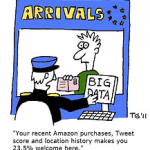 Can You Predict the Buyer’s Intent?
Can You Predict the Buyer’s Intent?
When you look through your lists of prospects do you sometimes wish for a magical net to capture those that will be productive and flush those that won’t? There is a lot of effort and money being poured into the area of “intent marketing” to try and provide such a screening process.
Intent marketing is a further illustration of the impact that analytics is having on marketing strategies and campaigns. It goes even further than predictive lead scoring to try and unearth net-new prospects that are likely to buy from you if only you can make the connection.
“There are thousands of buying signals outside of what you are able to track within your marketing automation and CRM platforms,” Brian Kardon, CMO at Lattice Engines, was quoted in a DemandGen Report article[i]. “Predictive analytics can help uncover the right patterns of traits that indicate when a customer or prospect is most likely to buy or even uncover traits of prospects or customers with the greatest revenue potential.”
 Kardon’s company and a growing bevy of competitors are tapping into a growing frustration with traditional lead scoring techniques and technology.
Kardon’s company and a growing bevy of competitors are tapping into a growing frustration with traditional lead scoring techniques and technology.
“Traditional CRM systems provide some metrics on the likelihood of leads converting to sales,” Derek Handova writes in an article for B2B New Network[ii]. “However, these metrics are based on retrospective rules. If only marketers had some source of intelligence that utilizes forward-looking data so that they could discern the good leads from the duds.”
Earlier this year, in an article for WIRED’s Innovation Insights blog, Madison Logic Data (since rebranded as Bombora) CEO Erik Matlick predicted that, “In 2015, B2B marketers will finally break free of legacy marketing methods and take a page from the B2C playbook, harnessing the power of intent to attract new customers and build lasting business relationships[iii].”
Matlick says that marketers will make Big Data “less big” and more manageable by utilizing tools and platforms to leverage lead scoring and predictive analytics. Currently, he says, “only about 20 percent of B2B marketers utilize lead scoring, even though it has been shown to increase deal close rates by 30 percent, company revenue by 18 percent and revenue per deal by 17 percent.” Marketing analytics in moving so fast it’s difficult for the average marketer to keep up. “With predictive technologies evolving so rapidly, it’s a common mistake to put lead scoring, predictive lead scoring and predictive intelligence in the same bucket[iv],” says Ellie Preyer at 6Sense, another tech provider. Preyer offers a short and sweet rundown of what distinguishes those categories.
If you, as a marketer, are beginning to think you need to go back to school and take some business intelligence/analytics courses, don’t despair just yet, there are plenty of vendors who want to help you out!
“We’re slowly seeing B2B media companies evolve,[v]” observes Integrate CMO Scott Vaughan in a Business2Community article. “They’re leveraging new technologies and long-held expertise to grow into sophisticated data repositories for their clients. This is great news for marketers. The optimism stems from the wealth of data types available today – big, small, prospect, intent, behavior and account intelligence. And, it appears more is on the way.”
Still, you have to wonder if the pace of technological infusion is a little too frantic, fueled by venture capital dollars more than actual marketing needs. As a recent article in the VC-oriented news outlet VentureBeat observes: “The modern marketing technology stack is often a horrific snaggle-toothed mess of purchased, inherited, acquired, forgotten, misused, and someone-really-still-uses-that tools, often owned and managed by multiple people, and not completely documented anywhere[vi].”
If that sounds a little too much like yesterday’s legacy enterprise IT environment, it may make sense to pull in the reins a little and focus on some tried and true intent marketing tactics. Our advice:
- Start with a contact list that is aligned with your sales and marketing teams
- Focus on qualified leads that have opted-in to talk with your sales force
- Generate account intelligence that enables your sales team to start off with a warm call instead of a cold call
The best way to gather intelligence on prospect intent is via a survey campaign, which provides crucial information to forearm the sales team on what prospects need; how far along the path they are to a decision; and other key indicators. Check out SimplyDIRECT’s Survey Checklist to quickly determine if a “lead-gen” survey can help generate leads and facilitate engagement between your sales team and your prospects.
[i] http://www.demandgenreport.com/industry-topics/demand-generation-strategies/3027-b2b-marketers-build-more-detailed-buyer-personas-to-fine-tune-targeting
[ii] http://www.b2bnn.com/2015/03/b2b-marketing-can-see-future-predictive-lead-scoring/
[iii] http://insights.wired.com/profiles/blogs/2015-the-year-of-b2b-intent-data#axzz3ftzyARNI
[iv] https://6sense.com/2014/12/the-differences-between-lead-scoring-predictive-lead-scoring-and-predictive-intelligence/
[v] http://www.business2community.com/big-data/your-best-marketing-data-provider-may-be-right-underneath-your-nose-01264168
[vi] http://venturebeat.com/?utm_source=vbnews&utm_medium=clicked-menu&utm_campaign=Logo
